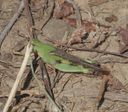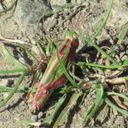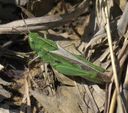Chortophagini
Chortophagini
Classification
- Phylum: Arthropoda
- Subphylum: Hexapoda
- Class: Insecta
- Order: Orthoptera
- Suborder: Caelifera
- Family: Acrididae
- Subfamily: Oedipodinae
- Tribe: Chortophagini
Pronunciation
How to pronounce Chortophagini: //kɔr.toʊˈfæ.dʒə.naɪ//
These audio files are automatically generated. While they are not always 100% accurate, they are a good starting point.
Images






Summary
The Chortophagini tribe encompasses a group of grasshoppers native to North America, characterized by their preference for moist habitats and several morphological traits that can vary between species.
Physical Characteristics
Most species of Chortophagini are rather smooth. The mid-dorsal ridge on the pronotum is typically obvious and cut only once, except for a few genera like Machaerocera and Shotwellia, which have a low, notched ridge. The fastigium is often narrow, with prominent raised margins, and the coloration of the body can include green, with wings usually being clear or somewhat yellowish with dark bands. Many species exhibit a darkened stigma at the hind wing's front edge.
Identification Tips
Look for a diagonal line on the color pattern of the eyes and a narrow, impressed fastigium. The mid-dorsal ridge of the pronotum can be a key identifying feature. Also, observe the wing coloration, which can vary significantly among species.
Habitat
Chortophagini species prefer moist meadowy environments such as stream margins, grassy meadows, woodland openings, and even alkali depressions, usually associated with rank grass or sedge growth.
Distribution
Primarily distributed in North America, with a notable presence in moist meadows and fields.
Diet
Chortophagini are herbivorous, feeding on various grasses and plants within their habitat.
Predators
Birds, small mammals, and other insectivorous animals are likely predators of Chortophagini grasshoppers, as is typical for many grasshopper species.
Ecosystem Role
As herbivores, Chortophagini play an important role in the ecosystem by influencing plant community dynamics and serving as prey for higher trophic levels.
Economic Impact
Some species are considered important locusts and may affect agriculture when populations are dense, such as Locusta migratoria and Chortoicetes terminifera.
Collecting Methods
- Hand collection
- Sweep nets
- Pitfall traps
Preservation Methods
- Ethanol preservation
- Pinning specimens
- Drying
Evolution
Chortophagini may share evolutionary close ties with the tribes Encoptolopus and Machaerocerini, as suggested by recent molecular studies.
Similar Taxa
- Encoptolophus
- Machaerocera
- Melanotettix
Misconceptions
They can be mistaken for locusts or other grasshoppers due to their appearance and behavior, particularly when they camouflage within grass.
Tags
- Grasshopper
- Orthoptera
- Chortophagini
- Insect
- Ecology